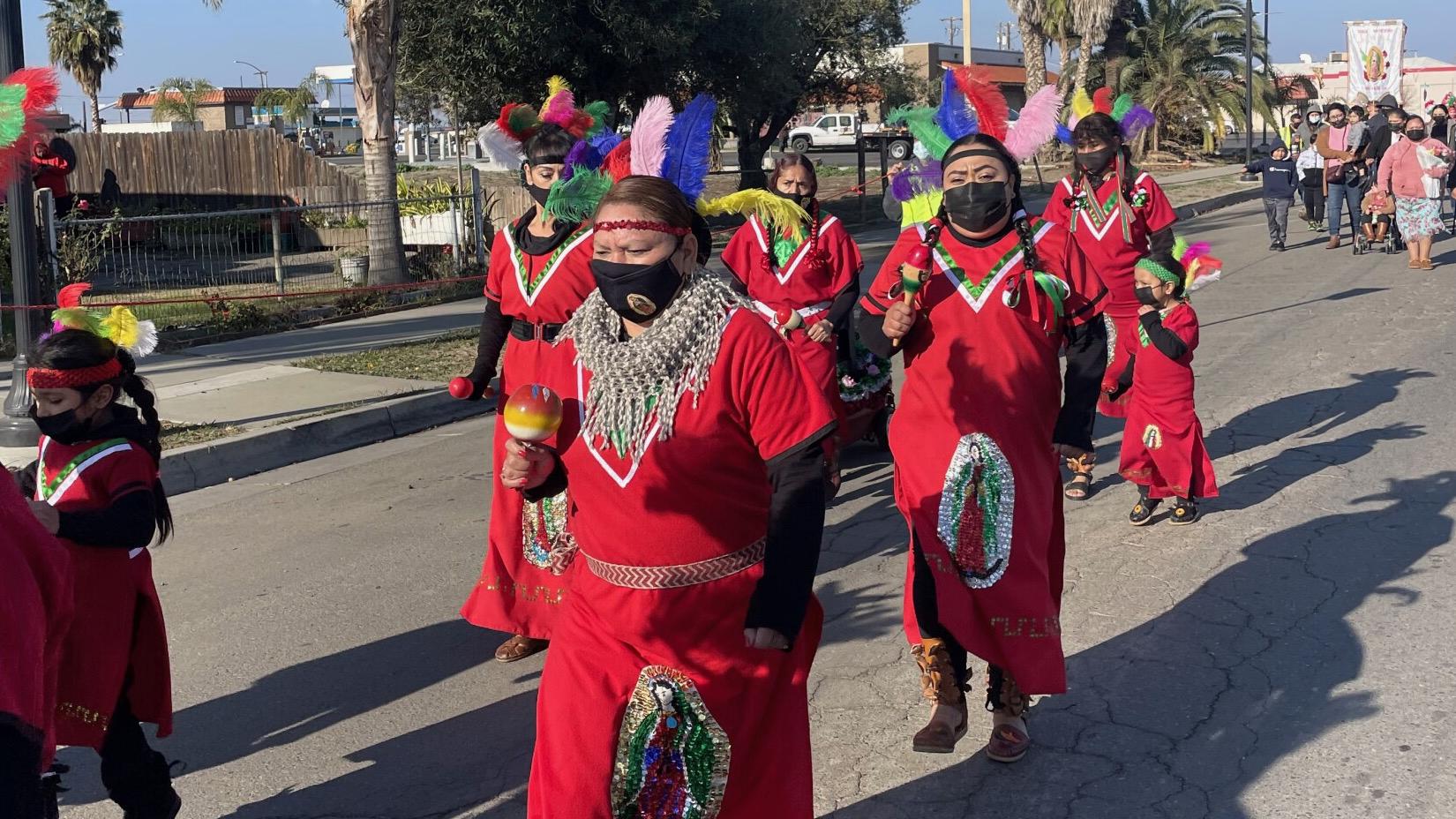Las Posadas holiday tradition brings ‘joy to the people’ in California community hit hard by the pandemic
A float decorated with images of the Virgen de Guadalupe winds from St. Joseph’s Catholic Church in Firebaugh, California, through neighborhoods of tiny pastel houses and passes the local park.
Evelia Garcia, 64, walks behind the float, chanting, “Viva la Virgen!” About 200 people walk behind her. Some residents of the small community set up chairs on their lawns to watch the procession, others hold their phones up to capture the moment.
Garcia is a petite woman who at first seems shy and soft-spoken. She’s wearing a red dress with an embroidered image of the Virgen de Guadalupe on the front. Twenty women and their daughters have on the same outfit. They’re a part of the dance group from St. Joseph’s Catholic Church.
Every December, Catholic Latinos across the state honor the Virgen de Guadalupe. The celebration of Las Posadas commemorates the appearance of Mary, the mother of Jesus, to an Indigenous man named Juan Diego in Mexico in 1531. Honoring that tradition was especially important this year for Firebaugh, a community that’s been hit hard during the pandemic.
Because of the pandemic, the beloved celebration was canceled last year and the dance group was unable to perform. COVID-19-hit, farmworker communities like Firebaugh especially hard and agricultural workers couldn’t afford to stay home.
Father Rayanna Pudota says after a year of immense loss, his parishioners were really excited about reviving the celebration of Las Posadas.
“People, they have faith and they are longing because for some time they missed this,” he says.
For sisters, teaching Aztec dance is a way to ‘do our part’
That’s especially true for Garcia, who is originally from Tequila, Jalisco, in Mexico. She says she grew up reciting the rosary every night with her siblings. Years later, she moved to a remote part of Fresno County with her husband. He worked in the fields and she worked at the local tomato processing facility.
“I lived in a rural area,” she says in Spanish, “so I couldn’t participate in church events.” But, she adds, it was important for her to continue practicing her faith.
Over time, Garcia and her husband saved up enough money to buy a car. That’s when Garcia says she started attending group prayers at St. Joseph’s. She loved it and started going to church seven days a week for nearly 40 years. Then, in December 2019, her husband died of colon cancer. Three months later, COVID-19 hit.
Garcia says the beginning of the pandemic was the loneliest time of her life.
Related: The US farmworker shortage spurs farmers to lobby for immigration reform
“I got sick of being indoors and with the churches closed,” she says. “It felt like I was dying, and my soul was dying, too.”
That changed when a friend from church brought Communion bread to her doorstep.
“The depressive feeling left me. Everything I was feeling disappeared and from then on I felt happier.”
“The depressive feeling left me,” she says. “Everything I was feeling disappeared and from then on I felt happier.”
She began praying again and helping the church in any way she could. She also joined the choir and started teaching Aztec dances for the Virgen de Guadalupe celebration.
“I learned some dances as a kid from her dad and the others I found online,” she says. “My sister and I would practice together and teach other dancers.”
Garcia’s sister, Marta, says dancing is in their blood.
“My dad taught dance, my brother dances, and my sister and I dance,” she says in Spanish. “We try to do our part.”
Virgen de Guadalupe celebration brings ‘joy to the people’
It’s not just the Garcia sisters. This tradition has brought a lot of families from Firebaugh together. Farmworker Maria Dolores Ramirez Martinez dances with her two daughters, ages 15 and 4. They’ve got feathers on their headdresses and they wear ayoyotes — or anklets festooned with hard shells — that shake and clank with every step.
Related: Kiki Valera on Son cubano and how he developed a unique musical perspective
“I feel grateful to be able to dance again because last year we couldn’t do it,” she says in Spanish. “Everyone was stuck inside, afraid to let their kids out, until now when they can celebrate again.”
Her oldest daughter, Arcelia Fuerte, agrees. For many, the Virgen de Guadalupe celebration is the first time since the start of the pandemic they’ve been able to celebrate their faith together and feel hopeful for the future.
“It’s really like to bring joy to the people because of COVID and the lives that were lost,” she says. “We just want to bring them happiness with our dances.”
This story was originally published by KVPR and is part of the Central Valley News Collaborative, which is supported by the Central Valley Community Foundation with technology and training support by Microsoft Corp.
The World is an independent newsroom. We’re not funded by billionaires; instead, we rely on readers and listeners like you. As a listener, you’re a crucial part of our team and our global community. Your support is vital to running our nonprofit newsroom, and we can’t do this work without you. Will you support The World with a gift today? Donations made between now and Dec. 31 will be matched 1:1. Thanks for investing in our work!
